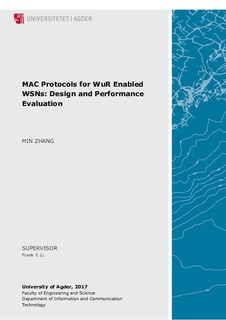| dc.description.abstract | Increasing energy efficiency is a challenging task for protocol design in wireless sensor networks
(WSNs) as well as in Internet of things (IoT). Traditionally, duty-cycled (DC) protocols
have been widely adopted for data transmissions in WSNs for energy conservation by reducing idle
listening and overhearing. Recently, wake-up radio (WuR) has merged as a promising technique to
replace DC protocols thanks to its superior performance in both network lifetime and transmission
latency. This thesis work focuses on the design and performance evaluation of WuR-enabled MAC
protocols considering various traffic conditions and network topologies.
As the first step, we investigate the niche of WuR by putting forward a question: Does WuR
always consume lower energy than DC protocols? Through in-depth analysis, we ascertain the
outstanding energy performance of WuR at light traffic loads. At the same time, we reveal its
disadvantages at heavy traffic loads.
Secondly, we propose a WuR protocol that is capable of avoiding WuC collisions by enabling
a contention-based collision avoidance mechanism for WuC transmissions. The performance of
the proposed protocol is evaluated by a Markov chain based mathematical model. Numerical results
indicate that our proposed protocol achieves higher packet delivery radio (PDR) and network
throughput, with the cost of slightly longer packet delay, compared with an existingWuR protocol.
Thirdly, we propose another WuR protocol, referred to as EHA-WuR, which is designed to
avoid energy hole in multi-hop networks for multipoint-to-point transmissions. Three operation
modes are designed for EHA-WuR. The proposed protocol is implemented in Omnet++ simulator.
Numerical results indicate that EHA-WuR significantly extends network lifetime compared with
the traditional hop-by-hop operation mode.
Key words: Wireless sensor networks, Internet of things, Wake-up radio, Collision avoidance,
Energy hole problem | nb_NO |

